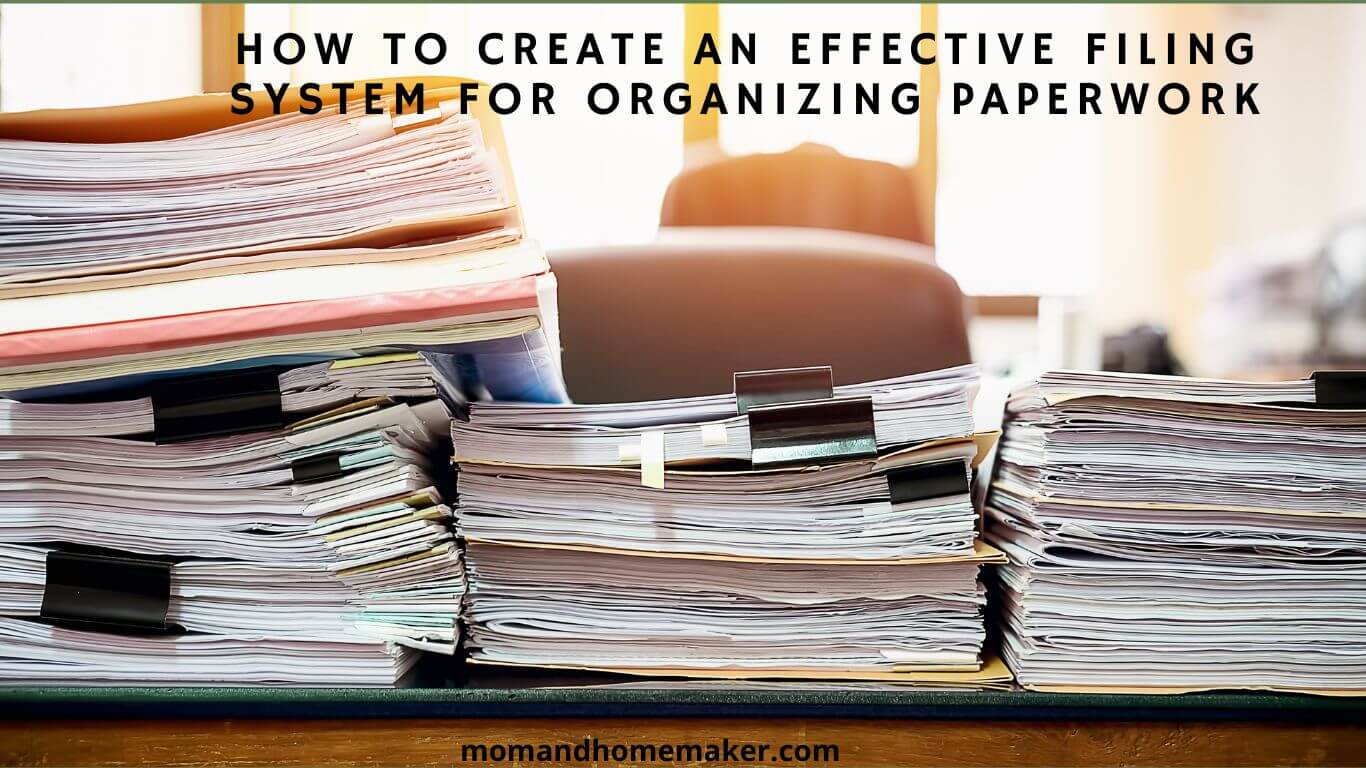Creating an effective filing system can help bring order to your paperwork and make your space feel more organized. From bills to important documents, the sheer volume of paper can quickly turn into chaos if not properly organized.
That’s where an effective filing system comes in. Having a well-organized filing system can not only save you time and frustration but also ensure that you have easy access to all your necessary paperwork when you need it.
Once you have your categories and method in place, it’s time to start organizing your paperwork. Start by sorting your documents into the appropriate categories. Label each folder or digital folder clearly, so you can easily find what you need later on.
By following these steps, you can create an efficient filing system that brings order to your paperwork and provides a sense of belonging in your space.

Assess Your Current Paperwork Situation
Assess your current paperwork organization to see how well you’ve been managing your documents. Take a look around your workspace and identify any areas that need improvement. Are there piles of unsorted papers scattered about? Are important documents getting lost in the chaos?
Once you’ve evaluated your current organization, it’s time to declutter and get organized. Sort through your paperwork and dispose of anything that’s no longer necessary. To make it easier to find important papers, consider creating separate folders or files for different categories like bills, receipts, and personal documents.
As you declutter and organize, it can be helpful to set deadlines for yourself. For example, you could aim to sort through one pile of paperwork each day or organize a certain number of folders per week. By creating a timeline, you’ll stay on track and complete your paperwork organization on time.
Determine Your Filing System Goals
When creating a filing system to organize your paperwork, it’s important to have clear goals in mind. Simplifying language and avoiding overused phrases, let’s discuss some key considerations for determining your filing system goals.
Setting priorities is crucial. It involves identifying which documents are most important for your daily operations or personal life. By prioritizing these key documents, you can ensure easy access and protection.
Streamlining processes is another goal to consider. This entails creating a system that allows for quick and efficient filing and retrieval, saving you time and effort.
Maximizing efficiency is essential. It means organizing your paperwork in a way that minimizes unnecessary searching or duplication of effort. This can greatly improve productivity and reduce stress.
Lastly, minimizing clutter is important for creating a clean and organized space. A clutter-free environment promotes a sense of calm and control.
To tailor your filing system goals to your unique needs, consider the specific challenges you face when dealing with paperwork. By keeping these goals in mind, you can create an efficient and organized filing system that gives you a sense of control over your paperwork.
Sort and Declutter Your Existing Paperwork
When it comes to organizing your paperwork, it’s important to start by sorting through your existing documents and decluttering them. This step is crucial for creating an efficient filing system that maximizes space and simplifies the paperwork process.
By using effective sorting techniques and efficient decluttering strategies, you can ensure that your filing system is practical and easy to navigate.
To get started, here are some practical tips for organizing your papers:
- Categorize by topic: Sort your paperwork into different categories based on their topics. This will make it easier to find specific documents when you need them.
- Alphabetical order: If you have a large number of documents, consider organizing them alphabetically. This can be helpful when searching for documents by their titles or names.
- Date order: Another way to sort your paperwork is by date order. This method is useful when you need to find documents based on when they were created or received.
In addition to sorting, decluttering is an essential part of organizing your paperwork. It involves getting rid of unnecessary documents and digitizing important ones to save space. Consider using color-coded folders for different categories and make sure to label them clearly and consistently for easy identification.
By following these effective sorting techniques and practical organization tips, you can establish a streamlined filing system that not only keeps you organized but also gives you a sense of control over your paperwork.
Gather Necessary Supplies for Your Filing System
Having the right supplies will make it easier to organize and locate your important documents whenever you need them. Let’s discuss the supplies you’ll need and some organization tips and storage options to help you create an efficient and effective filing system.
To start, you’ll need file folders, hanging folders, labels, and a filing cabinet or file box. File folders are great for keeping individual documents organized while hanging folders are ideal for grouping similar files.
Labels will help you quickly identify the contents of each folder, making it easier to find what you’re looking for. As for storage options, a filing cabinet is a popular choice for larger collections of paperwork, while a file box can be a more budget-friendly option for smaller amounts of paperwork.
If you’re looking for DIY solutions, consider repurposing items you already have at home. For example, you can use shoeboxes or magazine holders to store your files. This can be a creative and cost-effective way to organize your paperwork while adding a personal touch to your filing system.
Choose a Filing System Method That Suits Your Needs
When choosing a filing system that meets your needs, consider your organizational preferences and the types of documents you handle regularly. It’s important to select a system that resonates with you and simplifies the process of managing your paperwork. There are various options to consider, each with its advantages.
One method is using color-coded labels, which can personalize your filing system. By assigning different colors to categories or types of documents, you can easily locate what you need at a glance.
Another option is alphabetical organization, which is ideal for those who prefer a systematic approach. This method involves arranging files in alphabetical order based on their names or subjects.
If you deal with time-sensitive documents, chronological filing might be the best choice. This method involves organizing your paperwork in the order they were created or received. Functional file dividers can also help keep your files organized. These dividers allow you to separate different sections within a file, making it easier to find specific documents.
For individuals who need mobility, portable filing solutions are worth considering. These include file boxes or accordion folders that can be easily transported. They provide convenience and flexibility for those who frequently work on the go.
In the table below, you can compare the different filing system methods to determine which one suits your needs best:
| Method | Benefits |
|---|---|
| Color-coded labels | Personalization and easy visual identification |
| Alphabetical organization | Systematic approach for quick retrieval |
| Chronological filing | Ideal for time-sensitive documents |
| Functional file dividers | Helps separate sections within a file for better organization |
| Portable filing solutions | Convenient and flexible for on-the-go individuals |
Set up Physical Filing Folders or Containers
Once you have chosen a filing system method that suits your needs, it’s time to set up physical filing folders or containers.
Physical filing folders can be a reliable and efficient option for organizing paperwork at home, despite the increasing popularity of digital filing. Using color-coded folders can be particularly beneficial as they help you easily identify and locate specific documents. By assigning different colors to various categories or types of paperwork, you can streamline the filing process and save time.
To set up your physical filing system, start by sorting your documents into broad categories such as bills, insurance, tax, and personal records. Within each category, create subcategories to further organize your paperwork. It’s crucial to label each folder using descriptive and specific names to avoid confusion later on.
When organizing your paperwork, it’s important to avoid common mistakes that can hinder your filing system’s effectiveness. Regularly purge unnecessary documents, update folder labels, and create a designated space for incoming paperwork to keep your system running smoothly.
Finally, consider how to store and archive old files. Keep your active files within easy reach and store them in a secure and accessible location. For old files that you no longer need regularly, consider archiving them in a separate storage area.
Use archival quality boxes or containers to protect them from damage, and label the boxes with the date range and contents for easy retrieval when needed.
Establish a Naming Convention for Your Files
When it comes to organizing your paperwork, it’s essential to establish a naming convention for your files. This will help you keep your documents in order and make them easy to find when you need them.
By using a consistent and logical file naming system, you can save time and avoid frustration. Let’s explore some tips for creating an effective naming convention.
Be descriptive but concise. Include relevant information such as the document type, date, and subject matter. For example, instead of naming a file ‘Document 1,’ you could use a name like ‘Invoice_Jan2022_ClientName.’ This way, you can quickly identify the file without opening it.
Second, use a logical and consistent format. Consider using a combination of abbreviations, numbers, and keywords to create a standardized structure. For instance, you could use a format like ‘YYMMDD_Type_Subject’ to indicate the year, month, and day of the document, followed by the type and subject matter.
Avoid using special characters or spaces in your file names. Instead, use underscores or hyphens to separate words. This will ensure compatibility across different operating systems and software.
When organizing digital files, apply the same principles to your folder structure. Create folders with clear and meaningful names, and use subfolders to further categorize your documents. Incorporate your naming convention within these folders to maintain consistency.
Avoid generic names like ‘Document 1’ or ‘Final Version.’ Be specific and include distinguishing details in your file names. This will make it easier to locate the right document when you need it.
Create Broad Categories for Your Files
Start by organizing your files into broad categories. This is an essential step in creating an effective filing system. By categorizing your paperwork, you can easily locate and retrieve documents when needed. Categorization saves you time, reduces stress, and boosts productivity.
There are many benefits to having a well-organized filing system. First of all, it allows for easy access to important documents, eliminating the need to waste precious minutes searching for that crucial file.
It helps you maintain a clutter-free workspace, promoting a sense of calm and focus. Lastly, a well-organized filing system enhances your professional image by showcasing your efficiency and attention to detail.
To create effective broad categories, consider the different types of documents you handle regularly. Common categories may include financial records, client information, contracts, and correspondence. Make sure your categories are broad enough to encompass related documents, but not so broad that they become overwhelming.
Avoid common mistakes when categorizing files. Don’t create too many categories, as this can lead to confusion. Also, avoid using ambiguous category names that don’t clearly define the contents of the files.
To maintain and update your filing categories, regularly review and assess your system. Add new categories as needed and remove outdated ones. Ensure consistency in naming conventions and file placement. Regularly purge unnecessary documents to keep your filing system streamlined and efficient.
Utilize Subcategories for Further Organization
To better organize your paperwork, start by incorporating subcategories into your filing system. Using subcategories has several benefits and can greatly improve the overall organization of your documents. By breaking down your broad categories into smaller, more specific subcategories, you create a more refined and efficient filing system.
Here are some tips to help you effectively implement subcategories.
Consider the types of documents you have and group them based on their similarities. For example, if you have a broad category for ‘Financial Documents,’ you can create subcategories like ‘Bank Statements,’ ‘Tax Returns,’ and ‘Receipts.’
Another useful tip is to use meaningful and relevant subcategory examples that suit your specific needs. Customize the subcategories to fit your paperwork and make sure they make sense to you. This will make it easier for you to locate and retrieve documents when needed.
Proper subcategory organization is crucial for the success of your filing system. Make sure to label your folders or files clearly, using descriptive names that accurately represent the contents. This will help you easily identify where each document belongs and avoid confusion.
Lastly, ensure that you consistently implement your subcategories throughout your filing system. Regularly review and update your categories and subcategories as needed to accommodate any changes in your paperwork.
Label Your Files Clearly and Consistently
Labeling your files clearly and consistently is essential for maintaining an effective filing system. It allows for easy retrieval of important documents when needed. To create clear labels, use descriptive names that accurately represent the contents of each file. For example, instead of labeling a file as ‘Invoices,’ consider using a more specific label like ‘2021 Invoices – Client ABC.’ This level of detail will save you time and prevent confusion in the long run.
Consistent labeling offers numerous benefits. Firstly, it enables efficient document retrieval, saving you time and reducing frustration. Secondly, it promotes organization and order, making it easier to maintain a clutter-free workspace. Lastly, it ensures that important information is easily accessible, minimizing the risk of misplacing or losing crucial documents.
To ensure effective labeling, here are some tips to keep in mind:
- Use clear and concise labels
- Be consistent in your naming conventions
- Include dates or relevant keywords
Avoid common mistakes such as using vague or generic labels, neglecting to update labels when contents change, or overcomplicating labels with unnecessary information.
Develop a File Index or Inventory List
Developing a file index or inventory list is a crucial step in effectively organizing your paperwork. This document management tool greatly improves efficiency and makes retrieving files a breeze. By creating a file index or inventory list, you establish a tracking system that provides a comprehensive overview of your documents and their locations.
To create a file index or inventory list, start by organizing your documents into categories or types, such as financial records, legal documents, or client information. Within each category, further categorize your files with subcategories. For example, under financial records, you can have subcategories like invoices, receipts, and bank statements.
Once you have established your categories and subcategories, assign a unique identifier to each file or folder. This identifier can be a number or a combination of letters and numbers. Keep track of these identifiers in your file index or inventory list, along with the corresponding category and subcategory. This will make it easy to locate specific documents when needed.
By implementing a file index or inventory list, you streamline your document retrieval process and eliminate time wasted searching through disorganized folders. Instead, you can simply refer to your inventory list and quickly locate the document you need.
Take the time to create a file index or inventory list and enjoy the benefits of an organized and efficient filing system.
Implement a Regular Maintenance Schedule
Implementing a regular maintenance schedule is crucial for the continued effectiveness of your filing system. By regularly maintaining your system, you can keep your paperwork organized, save time, and enhance your overall productivity. Here are some practical tips to help you create an efficient maintenance schedule for your filing system:
- Sort and declutter: Set aside time each week to sort through your files and get rid of any unnecessary documents. This will prevent your system from becoming overwhelmed and ensure that you only have relevant and important papers.
- File new documents promptly: Make it a daily habit to file new documents as soon as you receive them. This will prevent piles of unorganized paperwork from accumulating on your desk and make it easier to find what you need when you need it.
- Review and update files: Take the time each month to review and update your files. Make sure everything is in its proper place and properly labeled. This will help you maintain an organized filing system and quickly locate any document you may need.
- Archive old documents: Annually, go through your files and archive any old documents that are no longer needed on a day-to-day basis but may be necessary for future reference. This will free up space in your active filing system and ensure that important information is safely stored.
- Backup digital files: Don’t forget to regularly backup your digital files to protect against potential data loss. This can be done quarterly to ensure that your important documents are securely stored.
Consider Digital Options for a Hybrid Filing System
If you want to improve the efficiency of your filing system, consider adding digital options to create a hybrid approach. This combination of physical and digital storage offers numerous benefits. With a hybrid system, you can organize your documents in a way that suits your needs.
One advantage of a hybrid system is the ease of managing both physical and digital files. You can store physical documents in traditional filing cabinets while also keeping digital copies on your computer or in the cloud. This allows for convenient access and retrieval, regardless of the format.
Organizing digital files is a crucial aspect of integrating technology into filing systems. Create a folder structure that mirrors your physical filing system, making it simple to locate documents digitally. Use descriptive file names and add metadata like tags or keywords to make searching even more efficient.
It’s important to have a clear system in place for managing physical and digital documents. Establish guidelines for when to scan physical documents into digital format and how to properly dispose of physical copies once they’ve been digitized. Regularly backing up your digital files ensures they won’t be lost due to technical issues or accidental deletion.
Incorporating digital options into your filing system can greatly improve organization and efficiency. By leveraging technology, you can seamlessly manage both physical and digital documents according to your preferences.
Back up Your Digital Files Regularly
Backing up your digital files regularly is crucial for ensuring their safety and security. In today’s digital age, having a reliable system in place for file organization and data backup is essential.
One effective way to back up your files is by utilizing cloud storage services. Cloud storage allows you to securely store your files on remote servers, providing easy access and protection against data loss. By regularly backing up your files to the cloud, you can rest assured knowing that your important documents, photos, and other digital assets are safe and easily retrievable if needed.
To better understand the benefits of cloud storage and data security, let’s take a look at the advantages of backing up your digital files:
- Protection against hardware failure: By storing your files in the cloud, you safeguard them from potential hardware failures that could result in data loss.
- Safe from physical damage or loss: Cloud storage ensures that your files are protected from physical damage or loss due to accidents, theft, or natural disasters.
- Easy access from anywhere: With cloud storage, you can access your files from any device with an internet connection, providing convenience and flexibility.
- Automatic backup options: Many cloud storage services offer automatic backup features, allowing you to schedule regular backups without manual intervention.
- A layer of data security: Cloud storage providers often have robust security measures in place to protect your files, adding an extra layer of data security.
By incorporating cloud storage into your file management system, you not only ensure the safety of your digital files but also become part of a community that prioritizes data security.
Review and Adjust Your Filing System as Needed
When reviewing and adjusting your filing system, it’s important to ensure that it remains efficient and organized. Evaluating the efficiency of your system is crucial in maintaining effective paperwork organization. Take the time to track your progress and determine if any adjustments are necessary. This will ensure that your filing system continues to meet your needs and helps you stay organized.
One way to evaluate the efficiency of your filing system is to seek feedback from users. Whether it’s your colleagues or family members, getting their input can provide valuable insights into how well the system is working. Ask them if they find it easy to locate documents and if any improvements could be made.
Based on the feedback received, make the necessary adjustments to your filing system. This might involve reorganizing folders, renaming categories, or adding new labels. Remember, the goal is to create a system that’s intuitive and user-friendly.
It’s also important to document any changes you make to your filing system. This will help you keep track of the adjustments and ensure consistency. Consider creating a log or spreadsheet to record the changes made, including the date and a brief description of the modification.
Conclusion
Creating an effective filing system for organizing paperwork is essential for maintaining order and efficiency. By implementing a well-organized system, you can easily locate and access important documents whenever needed. Regularly maintaining and adapting your filing system ensures a seamless flow of information. Simplify the language and avoid clichés to convey your message.
Another important aspect of an effective filing system is proper labeling. Clearly label each folder or file with a descriptive name that indicates its contents. This will save you time and effort when searching for specific documents. Periodically review and purge unnecessary or outdated files to keep your system clutter-free.
By following these simple yet effective steps, you can create a filing system that will bring order and efficiency to your paperwork. Remember, the key to a successful system is regular maintenance and adaptation as needed. With a well-organized filing system in place, you’ll be able to focus on what truly matters, knowing that your important documents are just a file away.

















